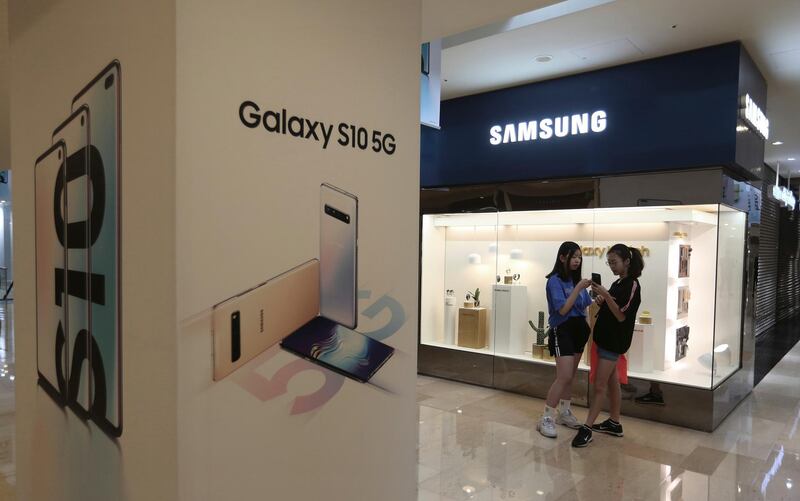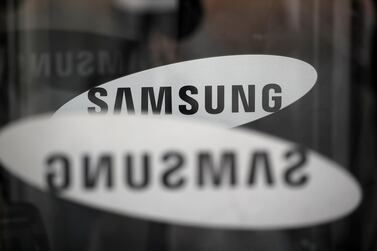Samsung Electronics joined rivals in cautiously predicting a rebound in chip prices in the second half of the year as demand from server-makers picks up.
The South Korean company’s guarded outlook, which echoed recent comments from SK Hynix, came after it posted first-quarter profit that missed estimates. It is the latest setback for a technology giant grappling with falling revenue from memory chips and an embarrassing delay of its highly touted foldable smartphone.
Its shares were little changed in Seoul.
Samsung posted an operating profit of 6.2 trillion won (Dh19.83 billion) in the quarter ended March, the smallest since late 2016.
Revenue fell 13.5 per cent to 52.4tn won. Net income fell to 5.11tn won in the three months ended March. That compares with the 5.7tn won average of estimates compiled by Bloomberg.
Income from the chips unit still amounted to 4.12tn won and most of the company’s profits. Samsung said that it will optimise its semiconductor lines in a move that could affect production volumes.
Contract prices for 32-gigabyte DRAM server modules, used to store data on PCs and servers, fell by 38 per cent in the March quarter, according to InSpectrum Tech. Prices for 128-gigabit MLC NAND flash memory chips, which store data on mobile devices, dropped by 23 per cent.
In its first-quarter financial report on Tuesday, Samsumg said it planned to lift sales based on competitive new models for each price range (including the Note series) and secure profitability "by increasing operational and cost efficiency, and enhance leadership in the premium market" by expanding sales of products such as 5G and foldable devices.
Samsung said it aimed to lead the global 5G market and "solidify a foundation for growth by expanding supply in the initial markets of Korea and the US and continue efforts to expand overseas 4G LTE networks".
The slowing expansion of data centres around the world has hurt demand for memory chips, while Chinese competition has eaten into Samsung’s smartphone businesses. This month, plunging chip sales led the company to report its worst operating profit in years, while it was forced to postpone the release of the Galaxy Fold after reports of screen failures. Still, Samsung now predicts improvement in the second half as customers reduce inventory and shift to higher-capacity chips.
“With memory in a pretty sharp downturn and LCD display prices also in a pretty sharp downturn, investors’ focus isn’t so much on today’s profitability,” said Mark Newman, senior research analyst at Sanford C Bernstein. “The question really is recovery in the second half of the year.”
SK Hynix said last week it was seeing clear signs of recovery starting in the second quarter, after posting its own sharp profit decline. Micron Technology said last month it was cutting production while forecasting improved demand in the second half.
Together with Hynix and Micron, Samsung controls the bulk of the market for DRAM, or dynamic random access memory. On Tuesday, Samsung executives said the company will sharply reduce investment in memory-related chip-making gear, a move that could tide it over a lull as it awaits a stronger industry rebound.
Samsung’s mobile division posted 2.27tn won in operating income. While the company remains the world’s biggest phone maker, its share of the market has been shrinking as Chinese rivals Huawei Technologies and Oppo catch up. The company, which shipped 78 million smartphones in the first quarter, expects sales to fall again in the second quarter.
The display division lost 560bn won for Samsung, which supplies OLED screens for Apple’s iPhones. Samsung’s consumer electronics unit, which includes TVs and appliances, recorded profit of 540bn won. It didn’t provide a new date for the delayed launch of its Galaxy Fold.
“Revenue for the mobile business will likely improve in the second quarter,” Park Sung-soon, an analyst with BNK Securities said. “What’s more important is chips. A recovery in the chips market will lead to a strong rebound in earnings in the second half.”
An easing China-US trade tensions could also unlock some demand for consumer electronics and encourage Chinese cloud service providers, which had stockpiled chips in anticipation of a prolonged trade war, to lower their inventories to more normal levels, analysts told Reuters.
"On the macroeconomic side, China may give a boost to its IT industry to support the economy and if there's a trade agreement signed between China and United States, these will drive up demand for Samsung's products, like chips," said senior analyst Song Myung-sup at HI Investment and Securities.







